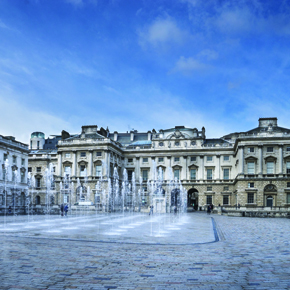
Electrical renovation: getting the balance right
 Luke Czerpak of electrical contractors Eaton Electrical explains to PSB Magazine some of the challenges associated with electrical renovation of historic public sector buildings…
Luke Czerpak of electrical contractors Eaton Electrical explains to PSB Magazine some of the challenges associated with electrical renovation of historic public sector buildings…
Local authorities, universities, charities and the health service have responsibility for thousands of listed buildings and heritage properties across the UK – from housing estates and schools through to stately homes, museums and art galleries.
While the maintenance of these buildings can be something of a challenge, it is essential that electrical systems be kept in good working order as electrical faults are cited as one of the major causes of fire in the both the workplace and the home. This is particularly important in older buildings where wiring is sometimes outdated or even hazardous.
The renovation of historic properties also requires a high level of skill in all aspects of work, from building to rewiring. In fact, carrying out an electrical refit within an older property often requires a significantly different approach, presenting a set of different challenges to a new or modern build.
Keeping the character
 Electricity is a relatively modern commodity and very few listed buildings were built with electrical systems in place. So, one of the key factors to consider when renovating electrical systems in a heritage property is to ensure that any work is in keeping with the character of the building. While the electrics may need to be state-of-the-art, they should complement their surroundings or be hidden as much as possible.
Electricity is a relatively modern commodity and very few listed buildings were built with electrical systems in place. So, one of the key factors to consider when renovating electrical systems in a heritage property is to ensure that any work is in keeping with the character of the building. While the electrics may need to be state-of-the-art, they should complement their surroundings or be hidden as much as possible.
As most heritage buildings were originally designed to accommodate only very limited services, electrical systems often have to be incorporated into structures that were never intended for them.
This means that electrical projects in older properties may require a different approach to system design, consigning as much of a new electrical installation as possible out of view to minimise the physical and visual impact on the building.
Electrical equipment is often concealed in ancillary rooms, such as cellars or storerooms. Voids such as roof spaces, floor cavities, redundant chimneys, gaps behind skirting boards, panelling and the inside of disused heating pipes may also be suitable sites. Reusing any previous holes, notches and cable routes can also aid discretion.
Controlling the environment
Museums and art galleries present a different set of challenges as they house old and precious artefacts and works of art, requiring careful storage and climate control. Such systems can be complex, running throughout a building and operating 24/7. They also need to be discreet and 100% reliable.
The Courtauld Gallery
The Courtauld Gallery in Somerset House is home to a world famous collection of impressionist and post-impressionist art works.
As part of a recent renovation project, we were required to convert a picture store within Somerset House into another gallery area. This was a technical and intricate project which required a high level of co-ordination with other services.
With some of the works of art in the gallery dating back over 700 years, a key part of the brief was to install a building management system which enabled the gallery to control the humidity and temperature in order to meet stringent guidelines set by Art Council England and ultimately protect the paintings – all while maintaining the elegant look of the interior.
In a heritage project, the electrical fittings and fixtures are likely to be of a different style and so any renovation needs to either replicate the original or use the originals with minimal damage. Existing fittings and fixtures can be adapted to provide building services, for example, gas lamps can be converted to modern light fittings.
However, the process may well involve using specialist craftsmen to undertake any building work, carpentry, decorating and plastering necessary to complete installation. It is also worth investing in good quality components and incorporating spare capacity to future-proof the building and avoid frequent re-wiring and associated damage.
Making use of modern technology
Modern technology can also be used to minimise invasive processes. Implementing technology such as radio frequency control can help to avoid unnecessary cabling – and any associated damage. The installation of specialist containment systems and cabling including steel conduit, micro bore tubing and MICC cabling can also help minimise any potential disruption.
Electrical renovation in older properties is a challenge – but a worthwhile one. The guiding principle is to ensure that you fully understand the brief and the character of the building that you are working in so it is equipped for the demands placed on it and preserved for the future.
Read more in the October issue of PSB Magazine
Latest news

22nd November 2024
Pop Up Power Supplies Gets Arty in Yorkshire
Pop Up Power Supplies has installed 13 new electricity units at The Hepworth Wakefield – read more in this article…
Posted in Articles, Building Industry News, Building Products & Structures, Building Services, Case Studies, Civil Engineering, Facility Management & Building Services, Garden, Hard Landscaping & Walkways, Landscaping, Posts, Restoration & Refurbishment, Retrofit & Renovation
22nd November 2024
OPT Services Revolutionises Fibre Cable Capping with Eco-Friendly Innovation
UK-based OPT Services has unveiled SlimLine™ Capping, a groundbreaking fibre cable protection solution that promises to deliver significant environmental and installation advantages to the fibre optic industry.
Posted in Articles, Building Industry News, Building Products & Structures, Building Services, Facility Management & Building Services, Information Technology, Innovations & New Products, Sustainability & Energy Efficiency
22nd November 2024
CRL: The elegance of Paris balconies - a modern touch for any home
Paris balconies, with their timeless charm and practicality, are becoming something of an architectural staple in urban and rural environments, as CRL explains here…
Posted in Articles, Balustrades and Guardrails, Building Industry News, Building Products & Structures, Case Studies, Garden, Glass, Glass Projects, Restoration & Refurbishment, Retrofit & Renovation
21st November 2024
Altro distils style and performance at English Spirit
English Spirit Distillery has used an extensive package of Altro products front and back of house, in their new visitor centre café, shop and viewing area for the working distillery.
Posted in Articles, Bathrooms, Bedrooms & Washrooms, Building Industry News, Building Products & Structures, Building Systems, Case Studies, Floors, Interior Design & Construction, Interiors, Kitchens, Restoration & Refurbishment, Retrofit & Renovation, Timber Buildings and Timber Products, Walls
 Sign up:
Sign up: